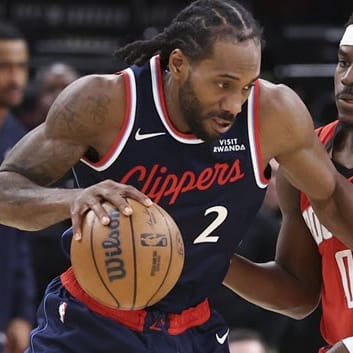2025 Stats
PTS
28.1
REB
6.6
AST
3.5
STL
2.1
BLK
0.7
ROS Projections
2025 Fantasy Outlook
The oft-injured Leonard made only 37 regular-season appearances last year, the second fewest in his career. His fewest came in 2017-18, when he appeared in only nine during his final year with the Spurs. Leonard has never been fully healthy, failing to crack 70 regular-season appearances in each season since 2014-15. However, the veteran superstar has still been able to deliver quality fantasy campaigns when he plays in enough games, proving time and time again that he can rebound from even the most devastating of injuries. Across five years in Los Angeles, Leonard has finished inside the top 25 in eight-category leagues three times. Despite the lack of regular-season games in 2024-25, Leonard actually finished the campaign healthy and playing extremely well. During a seven-game playoff series versus Denver, Leonard averaged 25 points, eight rebounds, five assists and nearly two stocks in 38 minutes per game while posting 54/78/40 shooting splits. A healthy offseason should bode well for Leonard's early-season outlook, but it would be shocking if he weren't monitored and/or limited, especially during back-to-back sets. The team around him has also been revamped, with the Clippers adding Brook Lopez, Chris Paul and John Collins while replacing Norman Powell with Bradley Beal. Los Angeles will certainly have to play games without Leonard next season, and James Harden has proven he's still capable of picking up the slack, but when Leonard is on the court, there are few players in the league who rival his impact. Read Past Outlooks

Logs double-double in narrow win
Leonard notched 24 points (10-25 FG, 0-8 3Pt, 4-4 FT), 12 rebounds, five assists, two blocks and one steal in 38 minutes during Monday's 103-102 victory over Golden State.
ANALYSIS
Leonard was able to muster 24 points despite missing all eight of his three-point attempts. The cold streak from downtown is probably the only bad mark you can give Leonard recently. He's enjoying some of the best basketball of his 14-year career, and it couldn't come at a better time for the Clippers, who are struggling to stay relevant in the West. Monday marks his second double-double in the last five games, and he's averaged 35.8 points, 7.6 rebounds, 3.6 assists, 2.8 steals, and 1.8 blocked shots over the five-game span.
Leonard was able to muster 24 points despite missing all eight of his three-point attempts. The cold streak from downtown is probably the only bad mark you can give Leonard recently. He's enjoying some of the best basketball of his 14-year career, and it couldn't come at a better time for the Clippers, who are struggling to stay relevant in the West. Monday marks his second double-double in the last five games, and he's averaged 35.8 points, 7.6 rebounds, 3.6 assists, 2.8 steals, and 1.8 blocked shots over the five-game span.
NBA Per Game Stats
Per Game
Total
Per 36
NBA Per Game Stats
Loading Per Game Stats...
2025 NBA Game Log
2025
2024
2023
2022
2020
2019
2018
2017
2016
2025 NBA Per Game Split Stats
Schedule
By Month
Starting/Off Bench
Days Rest
Vs Opp
By Result
2025 NBA Per Game Split Stats
Loading Split Stats...
Advanced Stats
Loading Advanced Stats...
Stat Review
2025
2024
2023
2022
2020
2019
2018
2017
2016
How does Kawhi Leonard compare to other players?
This section compares his stats with all players from the previous three seasons (minimum 200 minutes played)*. The bar represents the player's percentile rank. For example, if the bar is halfway across, then the player falls into the 50th percentile for that stat and it would be considered average.
True Shooting %
62.0%
Effective Field Goal %
55.6%
3-Point Attempt Rate
35.5%
Free Throw Rate
30.9%
Offensive Rebound %
3.5%
Defensive Rebound %
18.4%
Total Rebound %
11.2%
Assist %
19.3%
Steal %
2.7%
Block %
2.0%
Turnover %
7.6%
Usage %
32.1%
Fantasy Points Per Game
47.5
Fantasy Points Per Minute
1.4
NBA Historical Fantasy Stats
Historical ADP
Loading Historical ADP...
Clippers Depth Chart
Our full team depth charts are reserved for RotoWire subscribers.
Subscribe Now
Clippers Rotation: Minutes Breakdown
Loading Clippers Rotation Data...
Average Fantasy Points
Minutes
FanDuel
DraftKings
Yahoo
FantasyDraft
Head2Head
Sorare
Average Fantasy Points are determined when Kawhi Leonard was active vs. non-active during the season. Click here to view average fantasy points for a different time period.
Loading Average Minutes...
Past Fantasy Outlooks
2024
2023
2022
2021
2020
2019
2018
2017
2016
2015
2014
2013
2012
2011
Leonard played in 68 regular-season games last year, his most since making 74 appearances with San Antonio during the 2016-17 season. As usual, the veteran was a consistent producer, averaging at least 23.5 points, 6.0 rebounds, 3.0 assists and 1.4 steals for a fifth straight campaign -- Leonard missed 2021-22 rehabbing from an ACL injury. In those five seasons, the superstar forward has finished inside the top 22 in eight-category leagues four times, including an 11th-place finish in 2023-24. However, once again, Leonard suffered a knee injury during the postseason, putting his status for the start of 2024-25 in question. He was practicing with Team USA ahead of the 2024 Paris Olympics but had to withdraw before the exhibition showcase began. It was revealed in late September that Leonard had undergone offseason surgery and would be limited to start camp, making his return for the start of the year murky. With Paul George in Philadelphia, Leonard and James Harden will assume leading roles for the Clippers, who may struggle to flirt with contender status in a loaded Western Conference.
More Fantasy News

Strikes for 22 in Saturday's loss
Leonard contributed 22 points (6-17 FG, 2-8 3Pt, 8-8 FT), three rebounds, three assists, one block and three steals in 34 minutes during Saturday's 146-115 loss to the Celtics.
ANALYSIS
Subscribe now to instantly reveal our take on this news.
Subscribe now to instantly reveal our take on this news.

Dominant stretch continues
Leonard finished with 45 points (16-29 FG, 6-16 3Pt, 7-9 FT), seven rebounds, three assists, two blocks and two steals in 39 minutes during Thursday's 118-101 win over Utah.
ANALYSIS
Subscribe now to instantly reveal our take on this news.
Subscribe now to instantly reveal our take on this news.

Continues torrid run of production
Leonard had 33 points (11-19 FG, 5-9 3Pt, 6-7 FT), five rebounds, five assists, one block and three steals over 33 minutes during Tuesday's 131-90 win over the Kings.
ANALYSIS
Subscribe now to instantly reveal our take on this news.
Subscribe now to instantly reveal our take on this news.

Sets new high-scoring mark
Leonard went for 55 points (17-26 FG, 5-10 3Pt, 16-17 FT), 11 rebounds, five steals, three blocks and two assists in 38 minutes during Sunday's 112-99 win over the Pistons.
ANALYSIS
Subscribe now to instantly reveal our take on this news.
Subscribe now to instantly reveal our take on this news.

Explodes for 41 points
Leonard accumulated 41 points (16-23 FG, 4-5 3Pt, 5-5 FT), eight rebounds and five assists over 37 minutes during Tuesday's 128-108 win over the Rockets.
ANALYSIS
Subscribe now to instantly reveal our take on this news.
Subscribe now to instantly reveal our take on this news.
Latest Fantasy Rumors

Candidate for trade?
The Clippers could gauge the league-wide interest on Leonard by making available via trade, according to Mirjam Swanson of The Southern California News Group.
ANALYSIS
Leonard is the reigning Western Conference Player of the Week and could generate a ton of interest if made available via trade. The Clippers would probably ask for a king's ransom in return, but since their 2025-26 season has been so disappointing, it wouldn't hurt to see what they might get in return for the star forward. Leonard averaged 41.3 points, 9.0 rebounds and 2.7 steals per contest over the last week.
Leonard is the reigning Western Conference Player of the Week and could generate a ton of interest if made available via trade. The Clippers would probably ask for a king's ransom in return, but since their 2025-26 season has been so disappointing, it wouldn't hurt to see what they might get in return for the star forward. Leonard averaged 41.3 points, 9.0 rebounds and 2.7 steals per contest over the last week.















